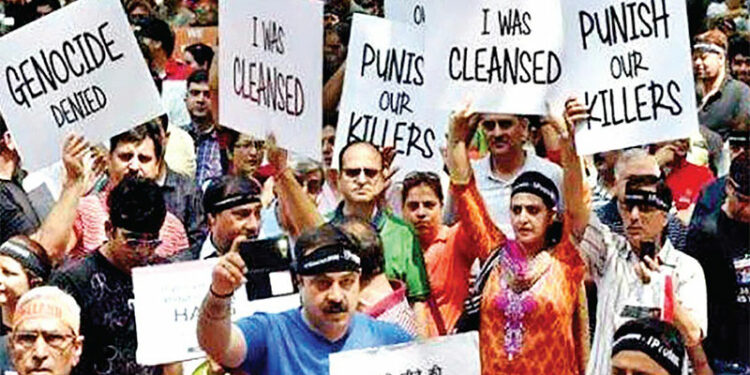Kashmiri Hindu Genocide: 7 times when the Kashmiri Hindus Had to face ‘Genocide’
January 19, 1990 brought more misery to the lives of Kashmir Hindus and subsequently led to their ethnic cleansing from Kashmir at the hands of Pakistani-sponsored separatists and terrorists……
January 19, 2023 marks the beginning of the 33th year of exile of the Kashmiri Pandits. More disturbing is the mute acceptance of this barbaric monstrosity by civil society and the media.
First Exodus.
The first exodus of the Hindu community in Kashmir happened in 1389-1413 CE, when Sultan Sikandar Shah, also known as Sikander Butshikan (destroyer of idols), unleashed an Islamic terror crusade throughout the Valley. During his tenure, temples were razed, and mosques were constructed in their place.
Second Exodus.
The second exodus was marked in Fateh Shah II’s reign, 1505-1514 CE. Shah came under the influence of Shams-Ud-din Araqi, who was a Noorbakshi Shi’a Sufi, and began the heinous practice of persecuting…
Third Exodus.
After the dismissal of the Shah Miri dynasty, Kashmir Valley went under the control of the Mughals, and after that, atrocities in line began on the Hindu community. The reign of Jahangir and Shahjahan.
Fourth Exodus.
Taking advantage of the declining Mughal Empire, the Durranis of Afghanistan took over control of the Kashmir Valley in 1752. The Durranis mastered Aurangzeb in cruelty, triggering the fourth exodus of the Kashmiri Pandits community.
Fifth Exodus.
A British officer’s cook, Abdul Qadeer, faced sedition charges for his fiery remarks against Maharaja Hari Singh in July 1931. The trial of Qadeer stirred up sentiments; protests were being held against the Dogra ruler. Things became ugly after the protesters were fired upon; this firing triggered communal violence in areas of Naushehra, Bohri Kadal etc. Since local Governor Trilok Chand gave the firing orders, the Kashmiri Pandits were targeted, attacked and ransacked.
Sixth Exodus.
Read more at: https://organiser.org/2023/01/19/104961/bharat/7-times-when-the-kashmiri-hindus-had-to-face-genocide/
Kashmir has not been a very peaceful land for longer periods. In the 1900s, the condition of Kashmiri Pandits kept deteriorating. A series of communal violence had been reported in the state. After 1947’s independence, Pakistan’s ISI-backed groups started pushing for the radicalisation of Kashmir. To sustain their agenda, they bred hatred against Kashmiri Pandits. There were concerted efforts to orchestrate a public relations campaign to change the Kashmiri people.
Seventh Exodus.
January 19, 1990 brought more misery to the lives of Kashmir Pandits and subsequently led to their ethnic cleansing from Kashmir at the hands of Pakistani-sponsored separatists and terrorists. The majority population in Kashmir slept or kept its eyes and ears shut even as fanatics danced on the Valley streets and roads, roared from loudspeakers atop mosques, threatening to rape and kill the ‘kafirs’ if they failed to leave Kashmir, “Asi gachchi Pakistan, Batao roas te Batanev san”
(we want to become Pakistan with Hindu women, not with their men). To free Kashmir from Kufra. Azadi ka matlab kya La ilaah illillaah.”.
Back in July 1988, a separatist organisation Jammu Kashmir Liberation Front (JKLF), started a separatist insurgency for the separation of Kashmir from India. On September 14, 1989, a prominent Kashmir.Hindu, namely Tika Lal Taploo, was attacked for the first time in Jammu & Kashmir. This instilled a sense of fear among the Kashmiri Pandits as Taploo’s killers were never arrested. The Hindus felt unsafe in Kashmir valley and feared being targeted at any time.
On January 4, 1990, a local Urdu newspaper, Aftab, published a press release issued by Hizb-ul-Mujahideen, asking all Pandits to leave the Valley immediately. The letter reads “We order you to leave the Valley immediately. The letter reads “We order you to leave Kashmir immediately; otherwise, your children will be harmed- we are not scaring you, but this land is only for Muslims, and is the land of Allah. Sikhs and Hindus cannot stay here. The threatening note ended with a warning, ‘If you do not obey, we will start with your children. Kashmir Liberation, Zindabad.”.
Later, another newspaper republished the same warning. Walls were pasted with posters threatening to all Kashmiris to strictly abide by specific rules like the Islamic dress code, video parlours and cinemas, and restrictions on women. Unknown masked men with arms forced people to reset their time to ‘Pakistan Standard Time’. Shops, office buildings and other establishments were coloured green as a sign of Islamic law, whereas on the other hand, homes and temples of Kashmiri Pandits were burned or destroyed. Threatening posters were pasted on the doors of Kashmiri Pandits houses, asking them to leave the Valley immediately.
According to Internal Displacement Monitoring Centre of the Norwegian Refugee Council (IDMC), 3,50,621 Kashmiri Pandits have been displaced from the valley since the insurgency began. Group massacres were common: Wandhama, Chapnari, Prankote and Nandimarg are a few of the localities that come to mind where groups of Hindus were mercilessly gunned down by terrorists, with the local population complicit in these killings.
